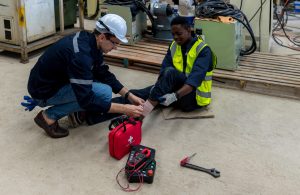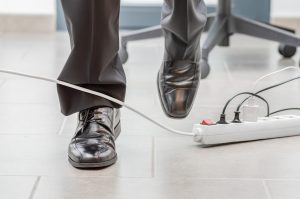What are your health and safety obligations on third party premises?
As an employer, your health and safety responsibilities don’t end when you leave the workplace. If you or your staff carry out work on third-party premises, you have a legal obligation to ensure the safety of everyone there who may be affected by your activities.
This was illustrated by a recent incident at a hospital in Scarborough. A company was hired to decontaminate one of the wards, but failed to properly seal the area in which they were working. This allowed ionised hydrogen peroxide to escape into adjoining rooms, leaving three members of hospital staff with life changing conditions. The company was prosecuted under The Health and Safety at Work Act 1974 and fined over £16,000.
The law states that employers must take reasonable steps to ensure that “persons other than themselves or their employees” are not put in danger as a result of their work. If you’re carrying out work on a third-party site, it’s important to conduct a full risk assessment before you start. In this case better training, supervision and monitoring of substance levels was called for.
This should highlight any potential risks to other workers or members of the public, and set out the measures you will take to control them. If you need help with this, don’t hesitate to ask.
Awards season antics
From Jarvis Cocker storming the stage at The Brits to Will Smith slapping Chris Rock at the Oscars, awards season is rarely short of drama. And with controversy already brewing around the Academy nominations, 2024 could be another vintage year for gossip columnists everywhere.
It can be entertaining when things go wrong at a televised event, but not when it happens in the workplace. Whether it’s an office party, a corporate function, or just a normal day at work, the unexpected can always occur. For this reason, the law requires every workplace to have a well-stocked first aid kit and an appointed person in charge of first aid.
While it’s not always a legal requirement, it’s also a good idea to have a trained first aider on site. We have years of experience in providing online and in-person training on all aspects of first aid. Give us a call to find out more.
When do I need to report a near miss?
Earlier this month, an asteroid the size of The Empire State Building passed within 1.7m miles of Earth. While this was hardly a cause for alarm, it could be considered a near miss by astronomical standards.
The chances of being hit by an asteroid may be slim, but near misses in the workplace should never be taken lightly. For every workplace accident there are an estimated 90 near misses, and these are often a sign of underlying weaknesses in your health and safety practices. If you don’t learn from a near miss, the next incident could be far more serious.
The HSE describes a near miss as an event that doesn’t cause harm but has the potential to do so. Common examples of near misses include:
- An employee tripping over an object or slipping on a wet floor but managing to steady themselves.
- A heavy object falling off a high shelf but not hitting anyone.
- A warehouse worker losing control of a forklift but only hitting a wall at low speed.
As we’re sure you know, you have a legal obligation to report serious accidents to the HSE. When it comes to near misses, though, the rules aren’t always so clear. RIDDOR regulations require you to report any accident that results in the death or serious injury of an employee, but you are also expected to report “dangerous occurrences”. This is a broad category covering many kinds of incident. Reportable near misses include:
- Incidents involving lifting equipment
- Electrical fires
- Explosions
- Incidents involving radiation or radiographic equipment
- Scaffolding collapses
- Train collisions
- Incidents involving pipelines
Most reportable near misses occur in industrial settings, but other workplaces have their share of hazards. While you probably won’t need to report office-based near misses, it’s a good idea to keep track of them internally. This will allow you to spot recurring dangers and adjust your health and safety policies accordingly.
The best approach is to create a formal procedure for reporting near misses. Make it clear to your employees that you expect them to report every incident either in writing or through an online form. These reports should include the time, date and location of the incident, a description of what happened and the contact details of everyone involved. If you’re unsure about this process, don’t hesitate to get in touch.
The hills have eyes
While most HSE prosecutions occur after a serious accident, this isn’t always the case. A company can be prosecuted for breaching health and safety rules even if nobody is harmed. The HSE receives dozens of tip-offs from whistleblowers and members of the public and, as a recent prosecution showed, it won’t hesitate to act on this information.
Last year, a company operating in docks was fined £100,000 after a member of the public filmed its employees using a forklift pallet as a mobile platform. Three employees were clearing equipment from a boat in Ramsgate Harbour when one of them used the pallet to reach the boat’s upper deck. Another then climbed from the deck onto the pallet carrying a piece of heavy machinery in clear violation of The Work at Height Regulations 2005.
As this incident shows, it’s not enough to be safe in theory. And let’s not forget, dozens of people die each year from falling from height in the workplace.
Creating a safe system of work is one thing, but getting employees to follow it is quite another. The best approach is to involve your workers in the process. Ask for their input when designing safe systems of work and encourage them to speak up if they see room for improvement.
Once your system is in place, it’s up to you to check that employees are following it. Check in with your staff on a regular basis, and provide refresher training if you notice standards beginning to slip. Remember that we live in the age of smartphones, and even a single mistake can become very public.
Service of the month: health and safety policies
As we’re sure you know, every business with five or more employees is required by law to have a written health and safety policy. Even if you don’t meet this threshold, a well-designed health and safety policy has many benefits. As well as ensuring legal compliance, it shows your staff that you value their safety. This can work wonders for morale, improving productivity and attracting the best talent to your company.
A health and safety policy is not something to be rushed. For it to be effective, it needs to be based on a thorough and accurate evaluation of your workplace. This is a lot to ask, especially for smaller companies with limited time and resources. Luckily, we can help.
At The Health & Safety Dept, we have years of experience in designing health and safety policies for businesses of all kinds. Our experts will take care of everything, from inspecting your site to drafting the policy itself. We can even review existing policies to make sure nothing has been missed.
Of course, designing a health and safety policy is only the beginning. We can also perform annual safety reviews and employee training to ensure that your safety standards never slip. Give us a call to get started.






